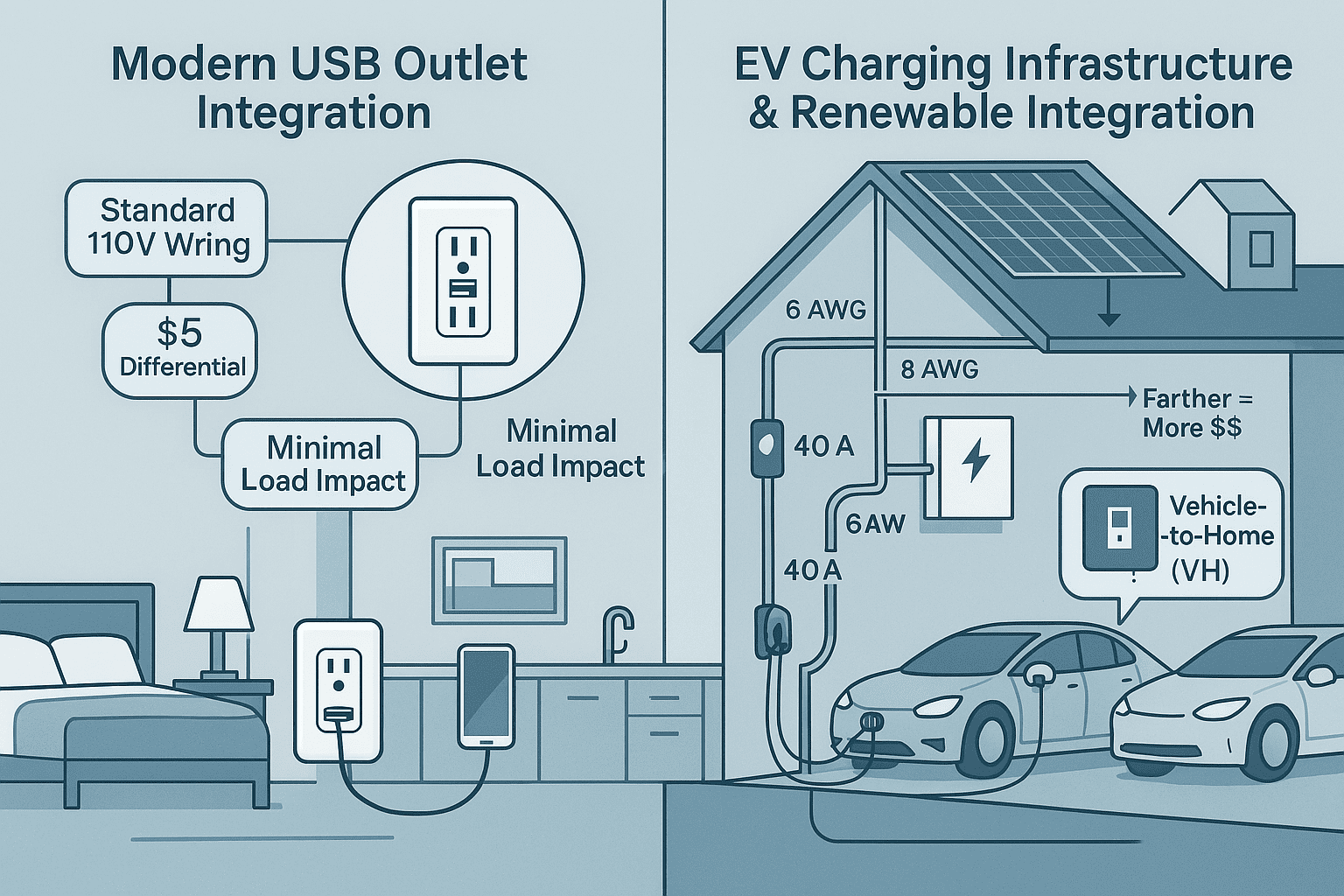As home electrification continues to grow, electrical contractors face increasing demand for USB charging outlets and electric vehicle charging infrastructure in residential settings. This article examines the technical considerations, wiring requirements, and installation best practices for these modern electrical features.
USB Outlets: Simple Implementation with High Consumer Appeal
Despite their technological sophistication, USB outlets represent one of the simplest upgrades in modern home wiring. As Ted Clifton of Zero-Energy Home Plans notes in the industry, these outlets require minimal additional investment:
- Installation Complexity: No special prewiring required—essentially a standard 110V outlet with integrated USB adapters
- Cost Differential: Approximately $5 more per outlet compared to standard receptacles
- Panel Capacity Impact: Negligible additional load on home electrical systems
- Location Planning: Typically installed in bedrooms, kitchens, home offices, and living areas
The simplicity of USB outlet integration makes them “practically table stakes” in new construction, offering builders an easy way to differentiate their properties with minimal cost impact.
EV Charging Infrastructure: Technical Requirements and Considerations
Unlike USB outlets, installing EV charging capabilities requires substantial technical planning:
Circuit Requirements
- Level 1 Charging: Standard 120V/15A circuit (minimal installation considerations)
- Level 2 Charging: Dedicated 240V circuit with 30A, 40A, or 50A capacity
- 30A circuits: Sufficient for vehicles with lower daily mileage
- 40A circuits: Recommended for primary vehicles with higher daily use
- 50A circuits: Maximum residential charging speed for high-demand scenarios
Wiring Specifications
- Wire Gauge Requirements:
- 30A circuit: 10 AWG copper conductors
- 40A circuit: 8 AWG copper conductors (approximately twice the cost of 10 AWG)
- 50A circuit: 6 AWG copper conductors
- Conduit and Routing Challenges:
- Larger conductor sizes require wider drilling through studs
- Cannot share pathways with plumbing runs
- Requires careful path planning to minimize material usage
Panel Considerations
- Service Capacity: Panel must be sized to accommodate additional high-amperage circuits
- Location Impact: “The farther an outlet is located from the main breaker panel, the more it will cost” (Clifton)
- Future Expansion: Planning for multiple charging stations requires appropriate bus capacity
Strategic Installation Approaches
New Construction Best Practices
- Bay-Specific Planning: Install one charging outlet per garage bay
- Higher amperage (40A) outlet nearest to panel for primary vehicle
- Standard 30A outlets for secondary vehicles or less frequent charging needs
- Panel Positioning: Strategic placement of electrical service to minimize conductor runs to garage
- Conduit Oversizing: Installing larger conduit than immediately necessary allows for future conductor upgrades
Retrofit Solutions
- Circuit-Sharing Technology: Specialized devices that allow EV chargers to share circuits with other high-draw appliances
- Example: Dryer/EV charger sharing systems that prioritize one device at a time
- Eliminates need for additional service capacity in some cases
- Panel Upgrades: May be necessary for older homes with limited electrical capacity
- Cost consideration: Panel upgrades can add $1,500-3,000 to installation costs
Integration with Renewable Systems
The most forward-thinking installations connect EV charging infrastructure with renewable energy systems:
Solar + EV Considerations
- Array Sizing: Additional solar capacity needed specifically for vehicle charging
- Typical EV adds 2,000-4,000 kWh annual consumption depending on driving patterns
- Solar system sizing should account for this additional load
- Battery Integration: Home battery systems can optimize charging patterns
- Charging vehicles from battery storage during peak rate periods
- Storing solar production for evening/night charging cycles
Bidirectional Charging Technology
As noted by Darrel McMaster of Sustainable Homes Inc., bidirectional charging represents the newest frontier:
- Vehicle-to-Home (V2H): Using EV batteries as backup power sources
- Reduced Battery Requirements: “Homeowners are now able to…downsize the size of the battery array to run their house during any event”
- Technical Requirements: Special inverters and compatible vehicles needed
Cost-Benefit Considerations
While installation costs vary significantly based on specific requirements, contractors should emphasize the long-term benefits:
- Energy Independence: Integrated systems provide resilience during grid outages
- Tax Advantages: As McMaster notes, “The utilities and the transportation costs are tax deductible”
- Home Value: EV-ready homes increasingly command premium pricing in competitive markets
Conclusion
For electrical contractors, the growing trend toward USB and EV integration presents significant revenue opportunities. The technical considerations, while substantial, can be addressed through thoughtful planning and proper execution. As consumer demand continues to rise—with over half of homebuilders now sizing panels for EV charging—mastering these installation techniques becomes increasingly essential for competitive electrical contractors.


0 Comments